Auditing Theory and Practice Report
VerifiedAdded on 2019/10/30
|12
|2654
|196
Report
AI Summary
This report details a comprehensive audit of GPSA, examining accounts receivable, current investments, property assets, intangible assets, and research & development capitalization. Financial ratios are used to analyze these accounts, revealing areas of concern such as increasing days sales outstanding and declining profitability. Significant audit risks are identified, including potential data misrepresentation and the impact of a declining property market. The report proposes strategies to mitigate these risks, such as utilizing audit software, avoiding rounding errors, and ensuring accurate tax return information. Furthermore, the report explores key business risks facing GPSA, including competition in the development of new medical devices, the reduction in property asset value, strategic risks associated with diverse business activities, and challenges related to adapting to technological changes. The effectiveness of internal controls is assessed, focusing on the impact of employee bonus schemes and a new IT system. Finally, the report discusses weaknesses in internal controls related to sales and trade receivables, highlighting issues such as inadequate documentation, work duplication, and the need for improved managerial oversight.
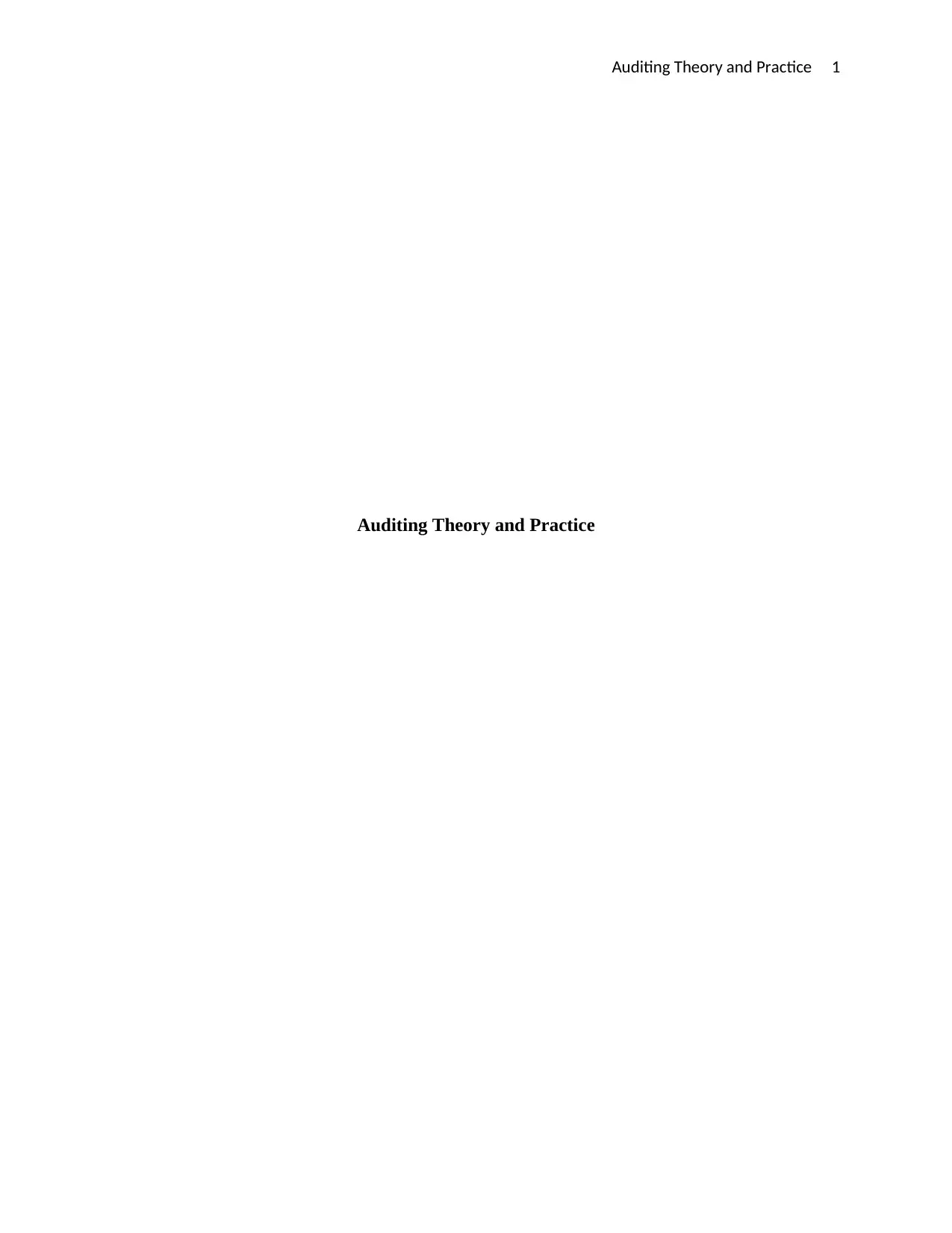
Auditing Theory and Practice 1
Auditing Theory and Practice
Auditing Theory and Practice
Paraphrase This Document
Need a fresh take? Get an instant paraphrase of this document with our AI Paraphraser
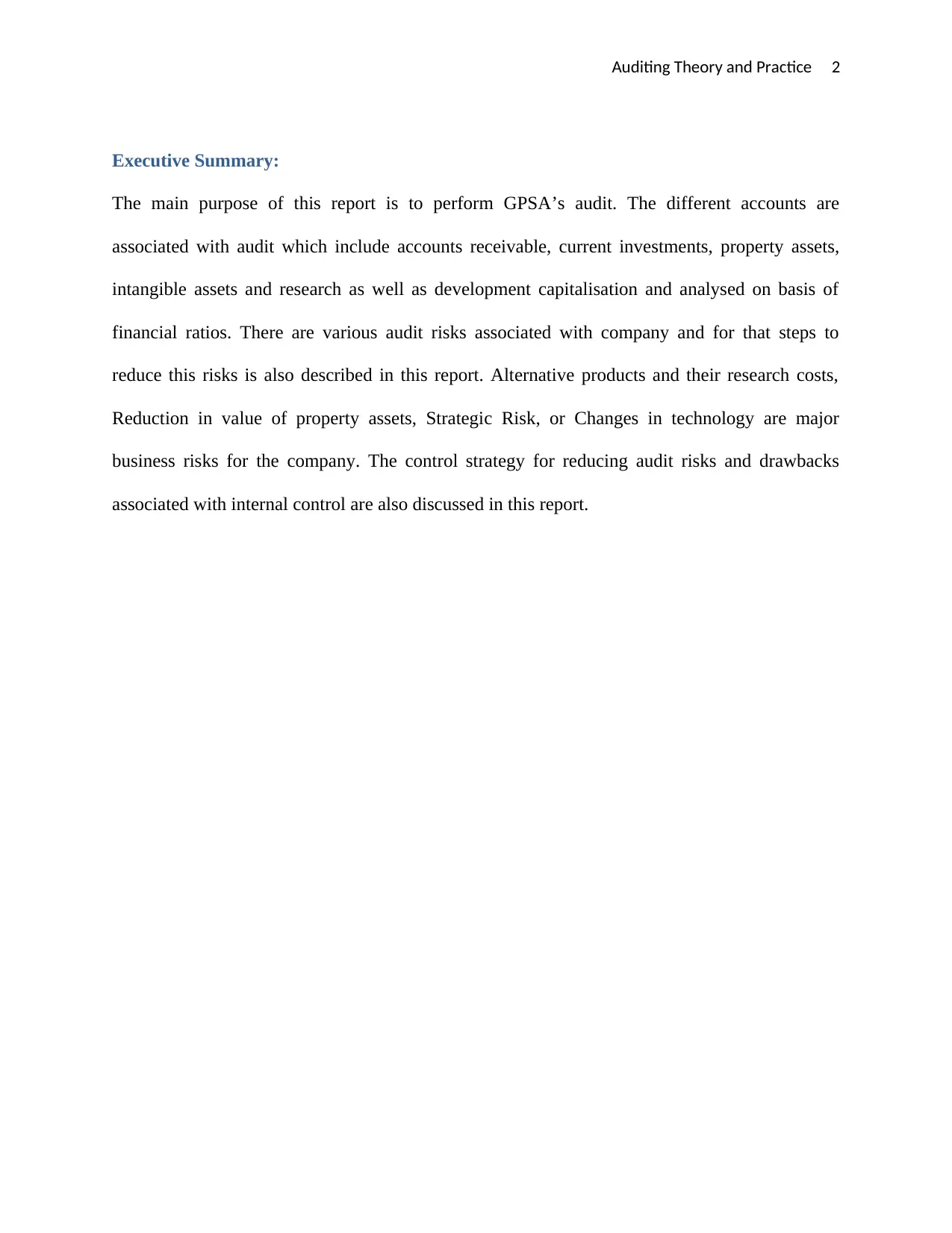
Auditing Theory and Practice 2
Executive Summary:
The main purpose of this report is to perform GPSA’s audit. The different accounts are
associated with audit which include accounts receivable, current investments, property assets,
intangible assets and research as well as development capitalisation and analysed on basis of
financial ratios. There are various audit risks associated with company and for that steps to
reduce this risks is also described in this report. Alternative products and their research costs,
Reduction in value of property assets, Strategic Risk, or Changes in technology are major
business risks for the company. The control strategy for reducing audit risks and drawbacks
associated with internal control are also discussed in this report.
Executive Summary:
The main purpose of this report is to perform GPSA’s audit. The different accounts are
associated with audit which include accounts receivable, current investments, property assets,
intangible assets and research as well as development capitalisation and analysed on basis of
financial ratios. There are various audit risks associated with company and for that steps to
reduce this risks is also described in this report. Alternative products and their research costs,
Reduction in value of property assets, Strategic Risk, or Changes in technology are major
business risks for the company. The control strategy for reducing audit risks and drawbacks
associated with internal control are also discussed in this report.
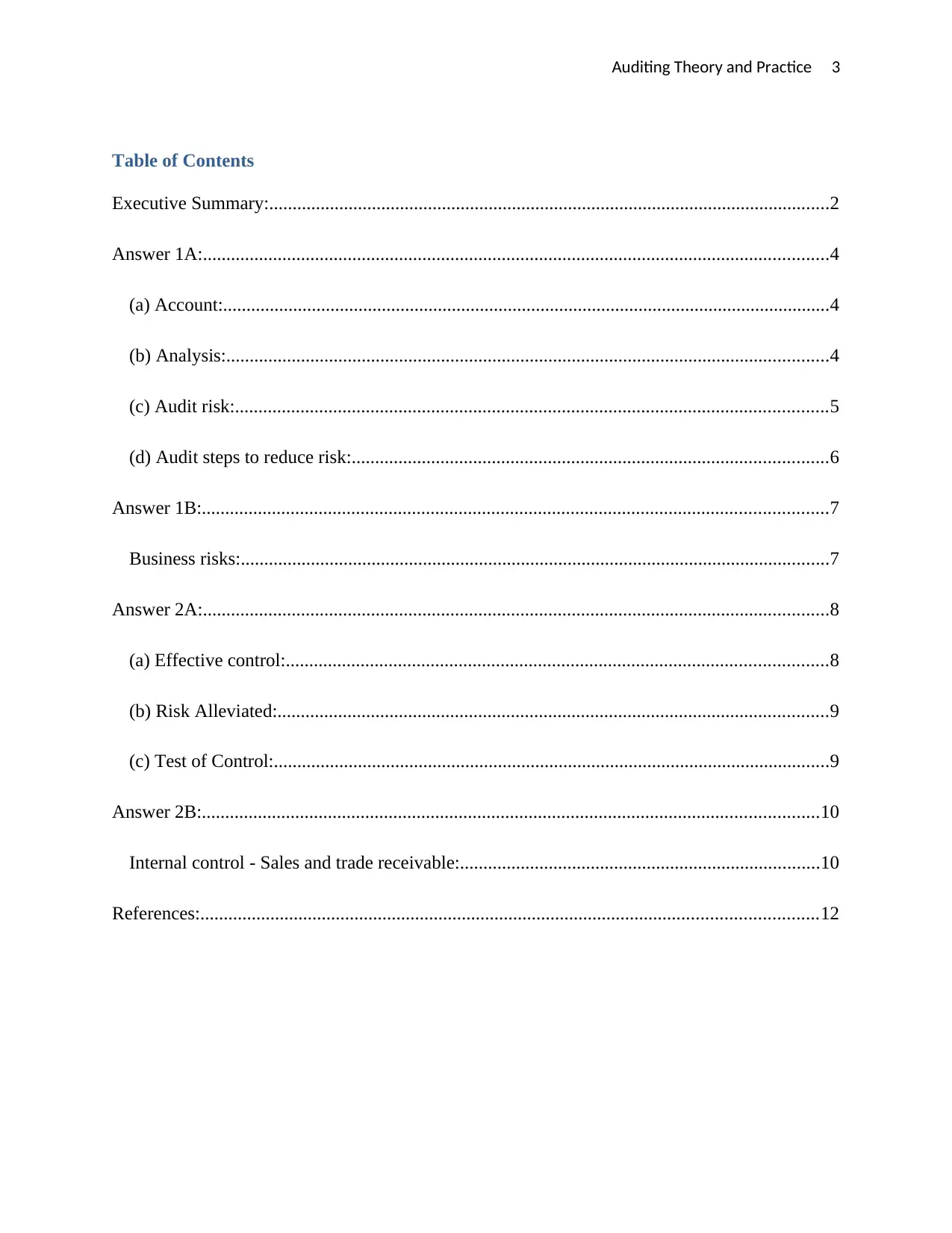
Auditing Theory and Practice 3
Table of Contents
Executive Summary:........................................................................................................................2
Answer 1A:......................................................................................................................................4
(a) Account:..................................................................................................................................4
(b) Analysis:.................................................................................................................................4
(c) Audit risk:...............................................................................................................................5
(d) Audit steps to reduce risk:......................................................................................................6
Answer 1B:......................................................................................................................................7
Business risks:..............................................................................................................................7
Answer 2A:......................................................................................................................................8
(a) Effective control:....................................................................................................................8
(b) Risk Alleviated:......................................................................................................................9
(c) Test of Control:.......................................................................................................................9
Answer 2B:....................................................................................................................................10
Internal control - Sales and trade receivable:.............................................................................10
References:....................................................................................................................................12
Table of Contents
Executive Summary:........................................................................................................................2
Answer 1A:......................................................................................................................................4
(a) Account:..................................................................................................................................4
(b) Analysis:.................................................................................................................................4
(c) Audit risk:...............................................................................................................................5
(d) Audit steps to reduce risk:......................................................................................................6
Answer 1B:......................................................................................................................................7
Business risks:..............................................................................................................................7
Answer 2A:......................................................................................................................................8
(a) Effective control:....................................................................................................................8
(b) Risk Alleviated:......................................................................................................................9
(c) Test of Control:.......................................................................................................................9
Answer 2B:....................................................................................................................................10
Internal control - Sales and trade receivable:.............................................................................10
References:....................................................................................................................................12
⊘ This is a preview!⊘
Do you want full access?
Subscribe today to unlock all pages.

Trusted by 1+ million students worldwide
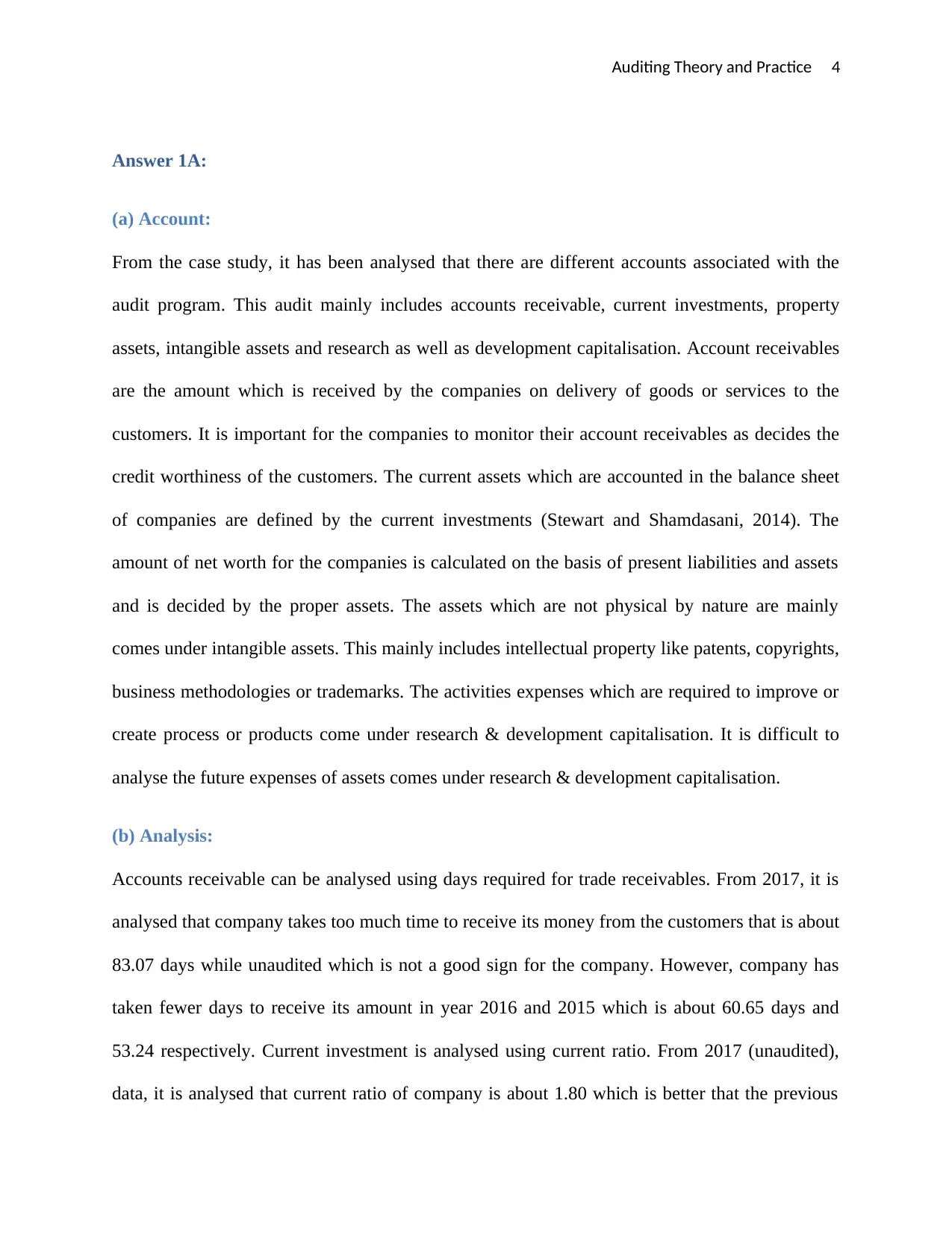
Auditing Theory and Practice 4
Answer 1A:
(a) Account:
From the case study, it has been analysed that there are different accounts associated with the
audit program. This audit mainly includes accounts receivable, current investments, property
assets, intangible assets and research as well as development capitalisation. Account receivables
are the amount which is received by the companies on delivery of goods or services to the
customers. It is important for the companies to monitor their account receivables as decides the
credit worthiness of the customers. The current assets which are accounted in the balance sheet
of companies are defined by the current investments (Stewart and Shamdasani, 2014). The
amount of net worth for the companies is calculated on the basis of present liabilities and assets
and is decided by the proper assets. The assets which are not physical by nature are mainly
comes under intangible assets. This mainly includes intellectual property like patents, copyrights,
business methodologies or trademarks. The activities expenses which are required to improve or
create process or products come under research & development capitalisation. It is difficult to
analyse the future expenses of assets comes under research & development capitalisation.
(b) Analysis:
Accounts receivable can be analysed using days required for trade receivables. From 2017, it is
analysed that company takes too much time to receive its money from the customers that is about
83.07 days while unaudited which is not a good sign for the company. However, company has
taken fewer days to receive its amount in year 2016 and 2015 which is about 60.65 days and
53.24 respectively. Current investment is analysed using current ratio. From 2017 (unaudited),
data, it is analysed that current ratio of company is about 1.80 which is better that the previous
Answer 1A:
(a) Account:
From the case study, it has been analysed that there are different accounts associated with the
audit program. This audit mainly includes accounts receivable, current investments, property
assets, intangible assets and research as well as development capitalisation. Account receivables
are the amount which is received by the companies on delivery of goods or services to the
customers. It is important for the companies to monitor their account receivables as decides the
credit worthiness of the customers. The current assets which are accounted in the balance sheet
of companies are defined by the current investments (Stewart and Shamdasani, 2014). The
amount of net worth for the companies is calculated on the basis of present liabilities and assets
and is decided by the proper assets. The assets which are not physical by nature are mainly
comes under intangible assets. This mainly includes intellectual property like patents, copyrights,
business methodologies or trademarks. The activities expenses which are required to improve or
create process or products come under research & development capitalisation. It is difficult to
analyse the future expenses of assets comes under research & development capitalisation.
(b) Analysis:
Accounts receivable can be analysed using days required for trade receivables. From 2017, it is
analysed that company takes too much time to receive its money from the customers that is about
83.07 days while unaudited which is not a good sign for the company. However, company has
taken fewer days to receive its amount in year 2016 and 2015 which is about 60.65 days and
53.24 respectively. Current investment is analysed using current ratio. From 2017 (unaudited),
data, it is analysed that current ratio of company is about 1.80 which is better that the previous
Paraphrase This Document
Need a fresh take? Get an instant paraphrase of this document with our AI Paraphraser
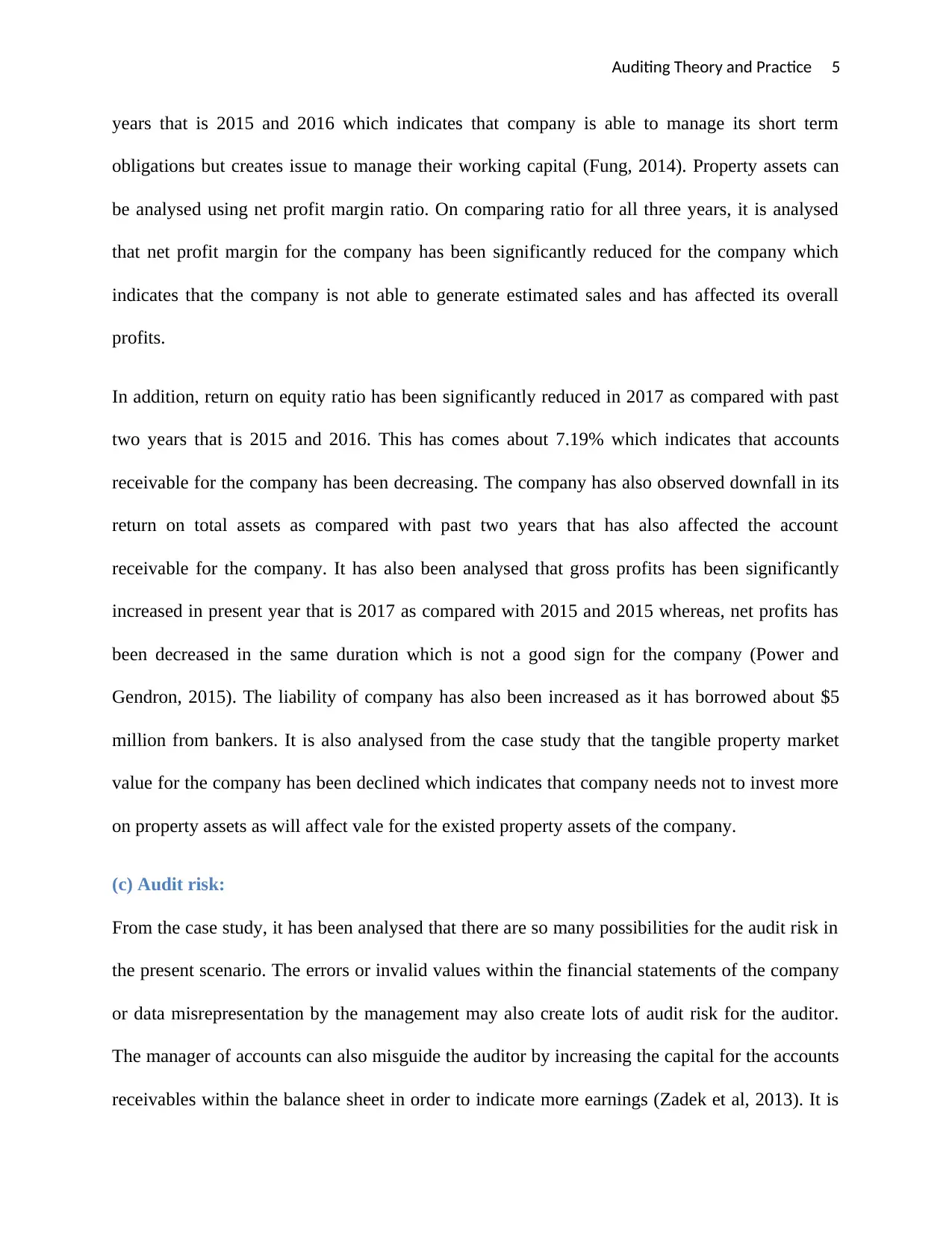
Auditing Theory and Practice 5
years that is 2015 and 2016 which indicates that company is able to manage its short term
obligations but creates issue to manage their working capital (Fung, 2014). Property assets can
be analysed using net profit margin ratio. On comparing ratio for all three years, it is analysed
that net profit margin for the company has been significantly reduced for the company which
indicates that the company is not able to generate estimated sales and has affected its overall
profits.
In addition, return on equity ratio has been significantly reduced in 2017 as compared with past
two years that is 2015 and 2016. This has comes about 7.19% which indicates that accounts
receivable for the company has been decreasing. The company has also observed downfall in its
return on total assets as compared with past two years that has also affected the account
receivable for the company. It has also been analysed that gross profits has been significantly
increased in present year that is 2017 as compared with 2015 and 2015 whereas, net profits has
been decreased in the same duration which is not a good sign for the company (Power and
Gendron, 2015). The liability of company has also been increased as it has borrowed about $5
million from bankers. It is also analysed from the case study that the tangible property market
value for the company has been declined which indicates that company needs not to invest more
on property assets as will affect vale for the existed property assets of the company.
(c) Audit risk:
From the case study, it has been analysed that there are so many possibilities for the audit risk in
the present scenario. The errors or invalid values within the financial statements of the company
or data misrepresentation by the management may also create lots of audit risk for the auditor.
The manager of accounts can also misguide the auditor by increasing the capital for the accounts
receivables within the balance sheet in order to indicate more earnings (Zadek et al, 2013). It is
years that is 2015 and 2016 which indicates that company is able to manage its short term
obligations but creates issue to manage their working capital (Fung, 2014). Property assets can
be analysed using net profit margin ratio. On comparing ratio for all three years, it is analysed
that net profit margin for the company has been significantly reduced for the company which
indicates that the company is not able to generate estimated sales and has affected its overall
profits.
In addition, return on equity ratio has been significantly reduced in 2017 as compared with past
two years that is 2015 and 2016. This has comes about 7.19% which indicates that accounts
receivable for the company has been decreasing. The company has also observed downfall in its
return on total assets as compared with past two years that has also affected the account
receivable for the company. It has also been analysed that gross profits has been significantly
increased in present year that is 2017 as compared with 2015 and 2015 whereas, net profits has
been decreased in the same duration which is not a good sign for the company (Power and
Gendron, 2015). The liability of company has also been increased as it has borrowed about $5
million from bankers. It is also analysed from the case study that the tangible property market
value for the company has been declined which indicates that company needs not to invest more
on property assets as will affect vale for the existed property assets of the company.
(c) Audit risk:
From the case study, it has been analysed that there are so many possibilities for the audit risk in
the present scenario. The errors or invalid values within the financial statements of the company
or data misrepresentation by the management may also create lots of audit risk for the auditor.
The manager of accounts can also misguide the auditor by increasing the capital for the accounts
receivables within the balance sheet in order to indicate more earnings (Zadek et al, 2013). It is
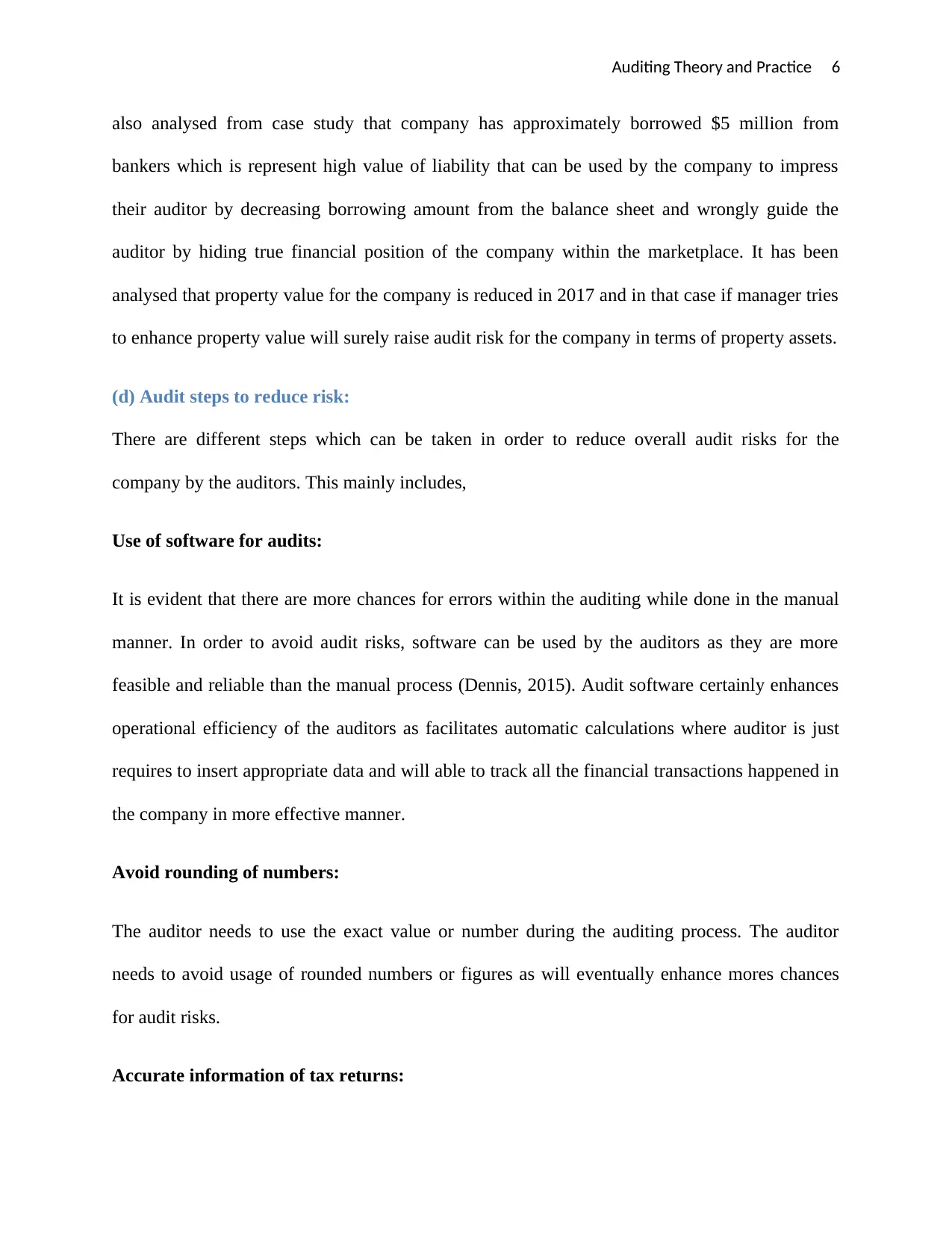
Auditing Theory and Practice 6
also analysed from case study that company has approximately borrowed $5 million from
bankers which is represent high value of liability that can be used by the company to impress
their auditor by decreasing borrowing amount from the balance sheet and wrongly guide the
auditor by hiding true financial position of the company within the marketplace. It has been
analysed that property value for the company is reduced in 2017 and in that case if manager tries
to enhance property value will surely raise audit risk for the company in terms of property assets.
(d) Audit steps to reduce risk:
There are different steps which can be taken in order to reduce overall audit risks for the
company by the auditors. This mainly includes,
Use of software for audits:
It is evident that there are more chances for errors within the auditing while done in the manual
manner. In order to avoid audit risks, software can be used by the auditors as they are more
feasible and reliable than the manual process (Dennis, 2015). Audit software certainly enhances
operational efficiency of the auditors as facilitates automatic calculations where auditor is just
requires to insert appropriate data and will able to track all the financial transactions happened in
the company in more effective manner.
Avoid rounding of numbers:
The auditor needs to use the exact value or number during the auditing process. The auditor
needs to avoid usage of rounded numbers or figures as will eventually enhance mores chances
for audit risks.
Accurate information of tax returns:
also analysed from case study that company has approximately borrowed $5 million from
bankers which is represent high value of liability that can be used by the company to impress
their auditor by decreasing borrowing amount from the balance sheet and wrongly guide the
auditor by hiding true financial position of the company within the marketplace. It has been
analysed that property value for the company is reduced in 2017 and in that case if manager tries
to enhance property value will surely raise audit risk for the company in terms of property assets.
(d) Audit steps to reduce risk:
There are different steps which can be taken in order to reduce overall audit risks for the
company by the auditors. This mainly includes,
Use of software for audits:
It is evident that there are more chances for errors within the auditing while done in the manual
manner. In order to avoid audit risks, software can be used by the auditors as they are more
feasible and reliable than the manual process (Dennis, 2015). Audit software certainly enhances
operational efficiency of the auditors as facilitates automatic calculations where auditor is just
requires to insert appropriate data and will able to track all the financial transactions happened in
the company in more effective manner.
Avoid rounding of numbers:
The auditor needs to use the exact value or number during the auditing process. The auditor
needs to avoid usage of rounded numbers or figures as will eventually enhance mores chances
for audit risks.
Accurate information of tax returns:
⊘ This is a preview!⊘
Do you want full access?
Subscribe today to unlock all pages.

Trusted by 1+ million students worldwide
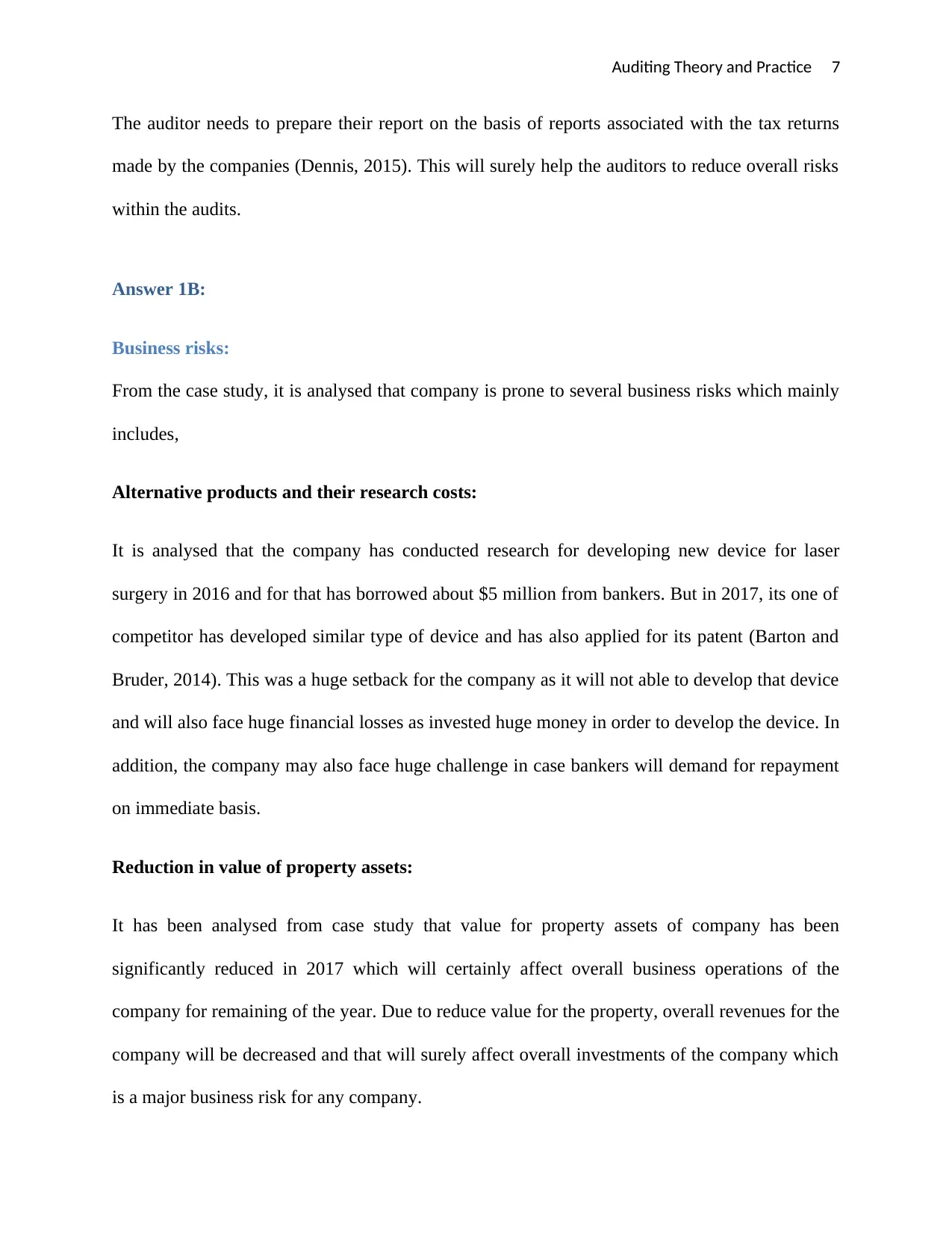
Auditing Theory and Practice 7
The auditor needs to prepare their report on the basis of reports associated with the tax returns
made by the companies (Dennis, 2015). This will surely help the auditors to reduce overall risks
within the audits.
Answer 1B:
Business risks:
From the case study, it is analysed that company is prone to several business risks which mainly
includes,
Alternative products and their research costs:
It is analysed that the company has conducted research for developing new device for laser
surgery in 2016 and for that has borrowed about $5 million from bankers. But in 2017, its one of
competitor has developed similar type of device and has also applied for its patent (Barton and
Bruder, 2014). This was a huge setback for the company as it will not able to develop that device
and will also face huge financial losses as invested huge money in order to develop the device. In
addition, the company may also face huge challenge in case bankers will demand for repayment
on immediate basis.
Reduction in value of property assets:
It has been analysed from case study that value for property assets of company has been
significantly reduced in 2017 which will certainly affect overall business operations of the
company for remaining of the year. Due to reduce value for the property, overall revenues for the
company will be decreased and that will surely affect overall investments of the company which
is a major business risk for any company.
The auditor needs to prepare their report on the basis of reports associated with the tax returns
made by the companies (Dennis, 2015). This will surely help the auditors to reduce overall risks
within the audits.
Answer 1B:
Business risks:
From the case study, it is analysed that company is prone to several business risks which mainly
includes,
Alternative products and their research costs:
It is analysed that the company has conducted research for developing new device for laser
surgery in 2016 and for that has borrowed about $5 million from bankers. But in 2017, its one of
competitor has developed similar type of device and has also applied for its patent (Barton and
Bruder, 2014). This was a huge setback for the company as it will not able to develop that device
and will also face huge financial losses as invested huge money in order to develop the device. In
addition, the company may also face huge challenge in case bankers will demand for repayment
on immediate basis.
Reduction in value of property assets:
It has been analysed from case study that value for property assets of company has been
significantly reduced in 2017 which will certainly affect overall business operations of the
company for remaining of the year. Due to reduce value for the property, overall revenues for the
company will be decreased and that will surely affect overall investments of the company which
is a major business risk for any company.
Paraphrase This Document
Need a fresh take? Get an instant paraphrase of this document with our AI Paraphraser
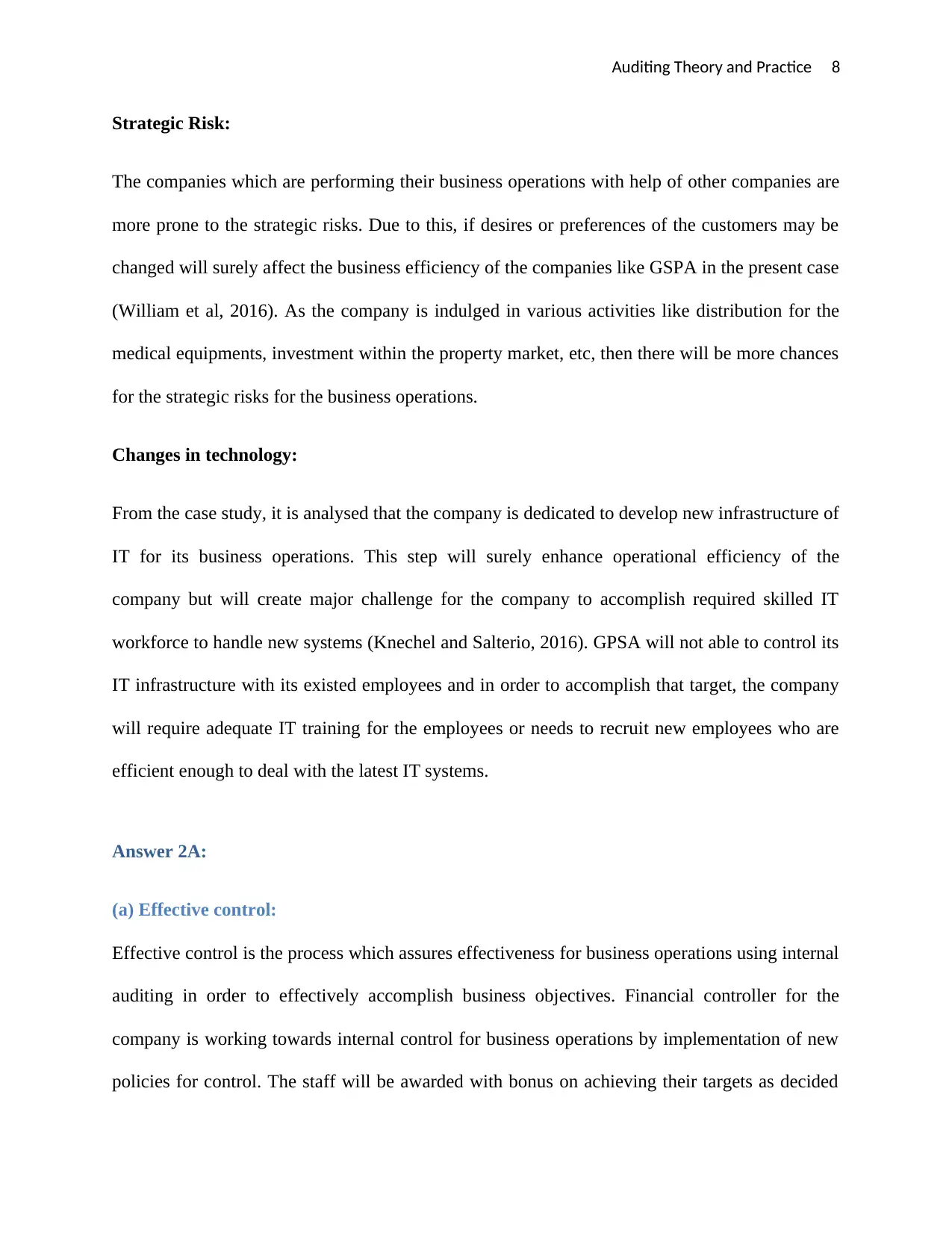
Auditing Theory and Practice 8
Strategic Risk:
The companies which are performing their business operations with help of other companies are
more prone to the strategic risks. Due to this, if desires or preferences of the customers may be
changed will surely affect the business efficiency of the companies like GSPA in the present case
(William et al, 2016). As the company is indulged in various activities like distribution for the
medical equipments, investment within the property market, etc, then there will be more chances
for the strategic risks for the business operations.
Changes in technology:
From the case study, it is analysed that the company is dedicated to develop new infrastructure of
IT for its business operations. This step will surely enhance operational efficiency of the
company but will create major challenge for the company to accomplish required skilled IT
workforce to handle new systems (Knechel and Salterio, 2016). GPSA will not able to control its
IT infrastructure with its existed employees and in order to accomplish that target, the company
will require adequate IT training for the employees or needs to recruit new employees who are
efficient enough to deal with the latest IT systems.
Answer 2A:
(a) Effective control:
Effective control is the process which assures effectiveness for business operations using internal
auditing in order to effectively accomplish business objectives. Financial controller for the
company is working towards internal control for business operations by implementation of new
policies for control. The staff will be awarded with bonus on achieving their targets as decided
Strategic Risk:
The companies which are performing their business operations with help of other companies are
more prone to the strategic risks. Due to this, if desires or preferences of the customers may be
changed will surely affect the business efficiency of the companies like GSPA in the present case
(William et al, 2016). As the company is indulged in various activities like distribution for the
medical equipments, investment within the property market, etc, then there will be more chances
for the strategic risks for the business operations.
Changes in technology:
From the case study, it is analysed that the company is dedicated to develop new infrastructure of
IT for its business operations. This step will surely enhance operational efficiency of the
company but will create major challenge for the company to accomplish required skilled IT
workforce to handle new systems (Knechel and Salterio, 2016). GPSA will not able to control its
IT infrastructure with its existed employees and in order to accomplish that target, the company
will require adequate IT training for the employees or needs to recruit new employees who are
efficient enough to deal with the latest IT systems.
Answer 2A:
(a) Effective control:
Effective control is the process which assures effectiveness for business operations using internal
auditing in order to effectively accomplish business objectives. Financial controller for the
company is working towards internal control for business operations by implementation of new
policies for control. The staff will be awarded with bonus on achieving their targets as decided
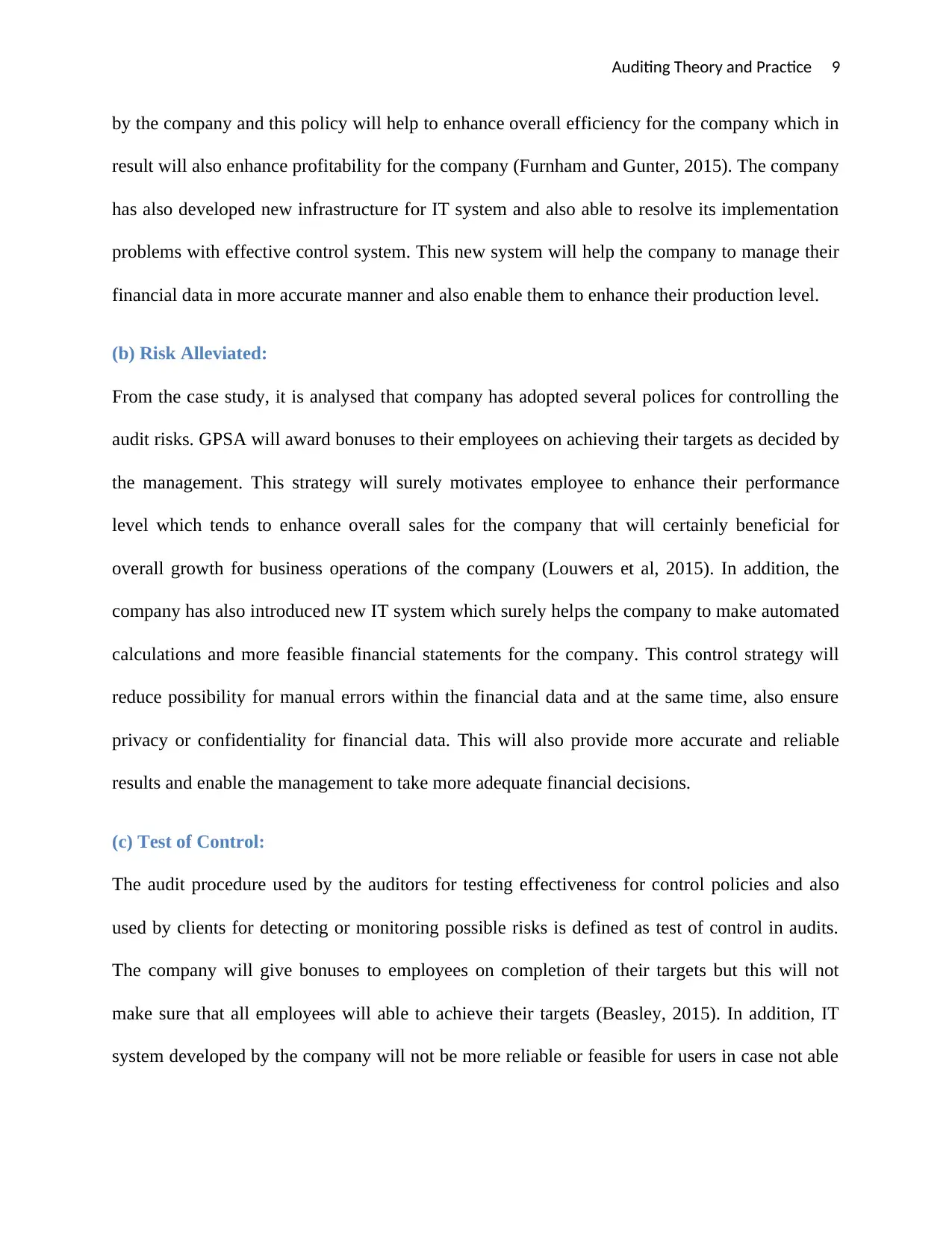
Auditing Theory and Practice 9
by the company and this policy will help to enhance overall efficiency for the company which in
result will also enhance profitability for the company (Furnham and Gunter, 2015). The company
has also developed new infrastructure for IT system and also able to resolve its implementation
problems with effective control system. This new system will help the company to manage their
financial data in more accurate manner and also enable them to enhance their production level.
(b) Risk Alleviated:
From the case study, it is analysed that company has adopted several polices for controlling the
audit risks. GPSA will award bonuses to their employees on achieving their targets as decided by
the management. This strategy will surely motivates employee to enhance their performance
level which tends to enhance overall sales for the company that will certainly beneficial for
overall growth for business operations of the company (Louwers et al, 2015). In addition, the
company has also introduced new IT system which surely helps the company to make automated
calculations and more feasible financial statements for the company. This control strategy will
reduce possibility for manual errors within the financial data and at the same time, also ensure
privacy or confidentiality for financial data. This will also provide more accurate and reliable
results and enable the management to take more adequate financial decisions.
(c) Test of Control:
The audit procedure used by the auditors for testing effectiveness for control policies and also
used by clients for detecting or monitoring possible risks is defined as test of control in audits.
The company will give bonuses to employees on completion of their targets but this will not
make sure that all employees will able to achieve their targets (Beasley, 2015). In addition, IT
system developed by the company will not be more reliable or feasible for users in case not able
by the company and this policy will help to enhance overall efficiency for the company which in
result will also enhance profitability for the company (Furnham and Gunter, 2015). The company
has also developed new infrastructure for IT system and also able to resolve its implementation
problems with effective control system. This new system will help the company to manage their
financial data in more accurate manner and also enable them to enhance their production level.
(b) Risk Alleviated:
From the case study, it is analysed that company has adopted several polices for controlling the
audit risks. GPSA will award bonuses to their employees on achieving their targets as decided by
the management. This strategy will surely motivates employee to enhance their performance
level which tends to enhance overall sales for the company that will certainly beneficial for
overall growth for business operations of the company (Louwers et al, 2015). In addition, the
company has also introduced new IT system which surely helps the company to make automated
calculations and more feasible financial statements for the company. This control strategy will
reduce possibility for manual errors within the financial data and at the same time, also ensure
privacy or confidentiality for financial data. This will also provide more accurate and reliable
results and enable the management to take more adequate financial decisions.
(c) Test of Control:
The audit procedure used by the auditors for testing effectiveness for control policies and also
used by clients for detecting or monitoring possible risks is defined as test of control in audits.
The company will give bonuses to employees on completion of their targets but this will not
make sure that all employees will able to achieve their targets (Beasley, 2015). In addition, IT
system developed by the company will not be more reliable or feasible for users in case not able
⊘ This is a preview!⊘
Do you want full access?
Subscribe today to unlock all pages.

Trusted by 1+ million students worldwide
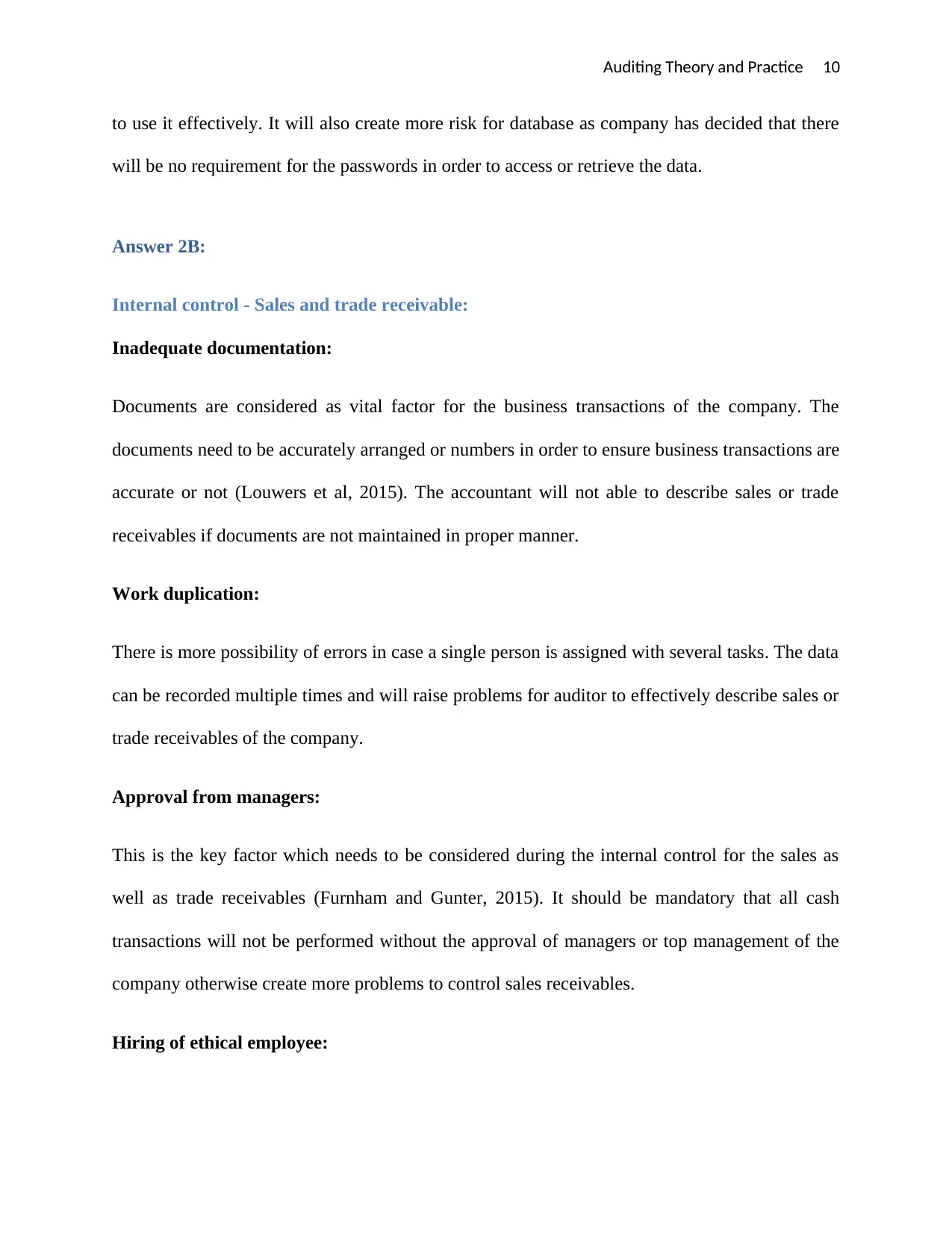
Auditing Theory and Practice 10
to use it effectively. It will also create more risk for database as company has decided that there
will be no requirement for the passwords in order to access or retrieve the data.
Answer 2B:
Internal control - Sales and trade receivable:
Inadequate documentation:
Documents are considered as vital factor for the business transactions of the company. The
documents need to be accurately arranged or numbers in order to ensure business transactions are
accurate or not (Louwers et al, 2015). The accountant will not able to describe sales or trade
receivables if documents are not maintained in proper manner.
Work duplication:
There is more possibility of errors in case a single person is assigned with several tasks. The data
can be recorded multiple times and will raise problems for auditor to effectively describe sales or
trade receivables of the company.
Approval from managers:
This is the key factor which needs to be considered during the internal control for the sales as
well as trade receivables (Furnham and Gunter, 2015). It should be mandatory that all cash
transactions will not be performed without the approval of managers or top management of the
company otherwise create more problems to control sales receivables.
Hiring of ethical employee:
to use it effectively. It will also create more risk for database as company has decided that there
will be no requirement for the passwords in order to access or retrieve the data.
Answer 2B:
Internal control - Sales and trade receivable:
Inadequate documentation:
Documents are considered as vital factor for the business transactions of the company. The
documents need to be accurately arranged or numbers in order to ensure business transactions are
accurate or not (Louwers et al, 2015). The accountant will not able to describe sales or trade
receivables if documents are not maintained in proper manner.
Work duplication:
There is more possibility of errors in case a single person is assigned with several tasks. The data
can be recorded multiple times and will raise problems for auditor to effectively describe sales or
trade receivables of the company.
Approval from managers:
This is the key factor which needs to be considered during the internal control for the sales as
well as trade receivables (Furnham and Gunter, 2015). It should be mandatory that all cash
transactions will not be performed without the approval of managers or top management of the
company otherwise create more problems to control sales receivables.
Hiring of ethical employee:
Paraphrase This Document
Need a fresh take? Get an instant paraphrase of this document with our AI Paraphraser
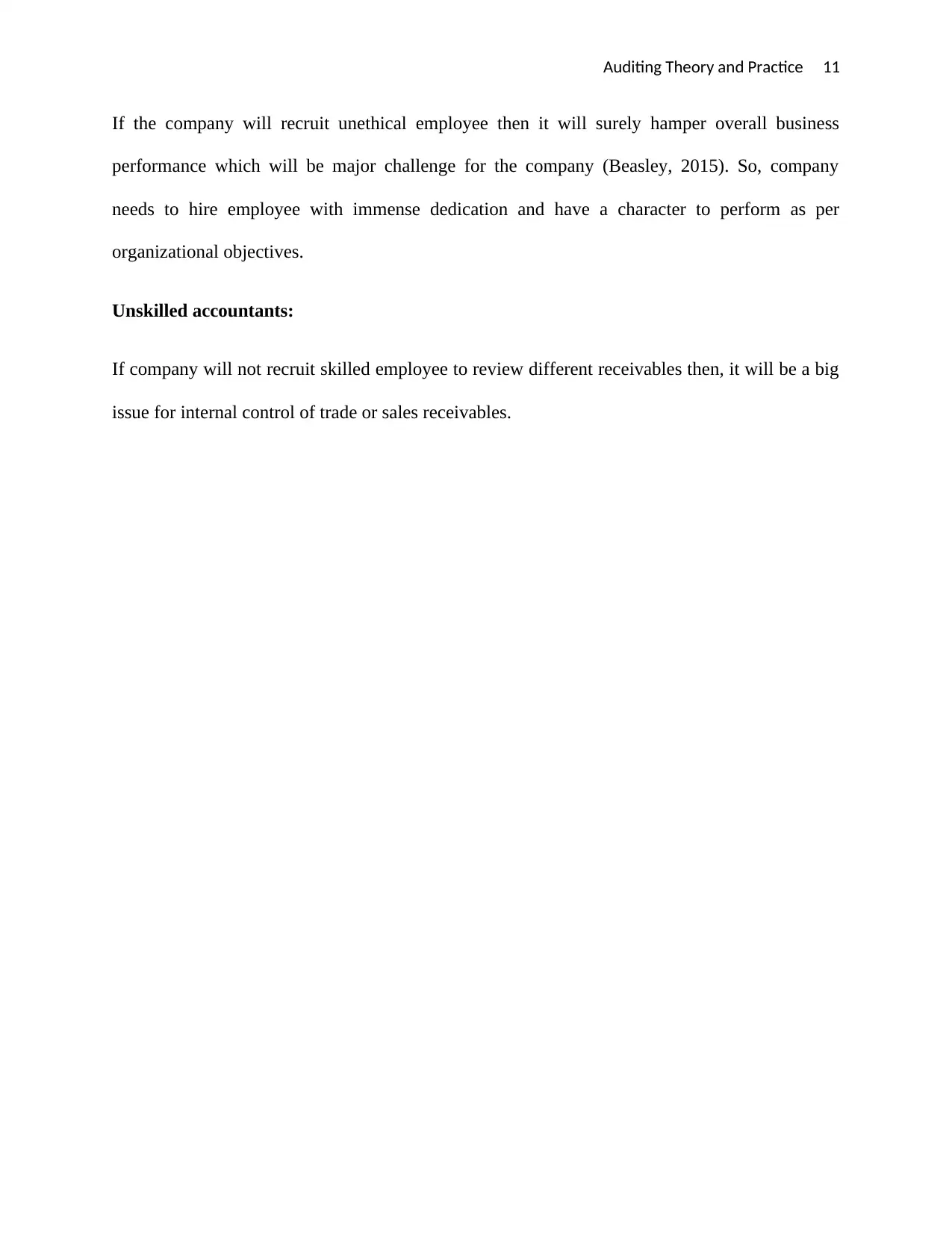
Auditing Theory and Practice 11
If the company will recruit unethical employee then it will surely hamper overall business
performance which will be major challenge for the company (Beasley, 2015). So, company
needs to hire employee with immense dedication and have a character to perform as per
organizational objectives.
Unskilled accountants:
If company will not recruit skilled employee to review different receivables then, it will be a big
issue for internal control of trade or sales receivables.
If the company will recruit unethical employee then it will surely hamper overall business
performance which will be major challenge for the company (Beasley, 2015). So, company
needs to hire employee with immense dedication and have a character to perform as per
organizational objectives.
Unskilled accountants:
If company will not recruit skilled employee to review different receivables then, it will be a big
issue for internal control of trade or sales receivables.
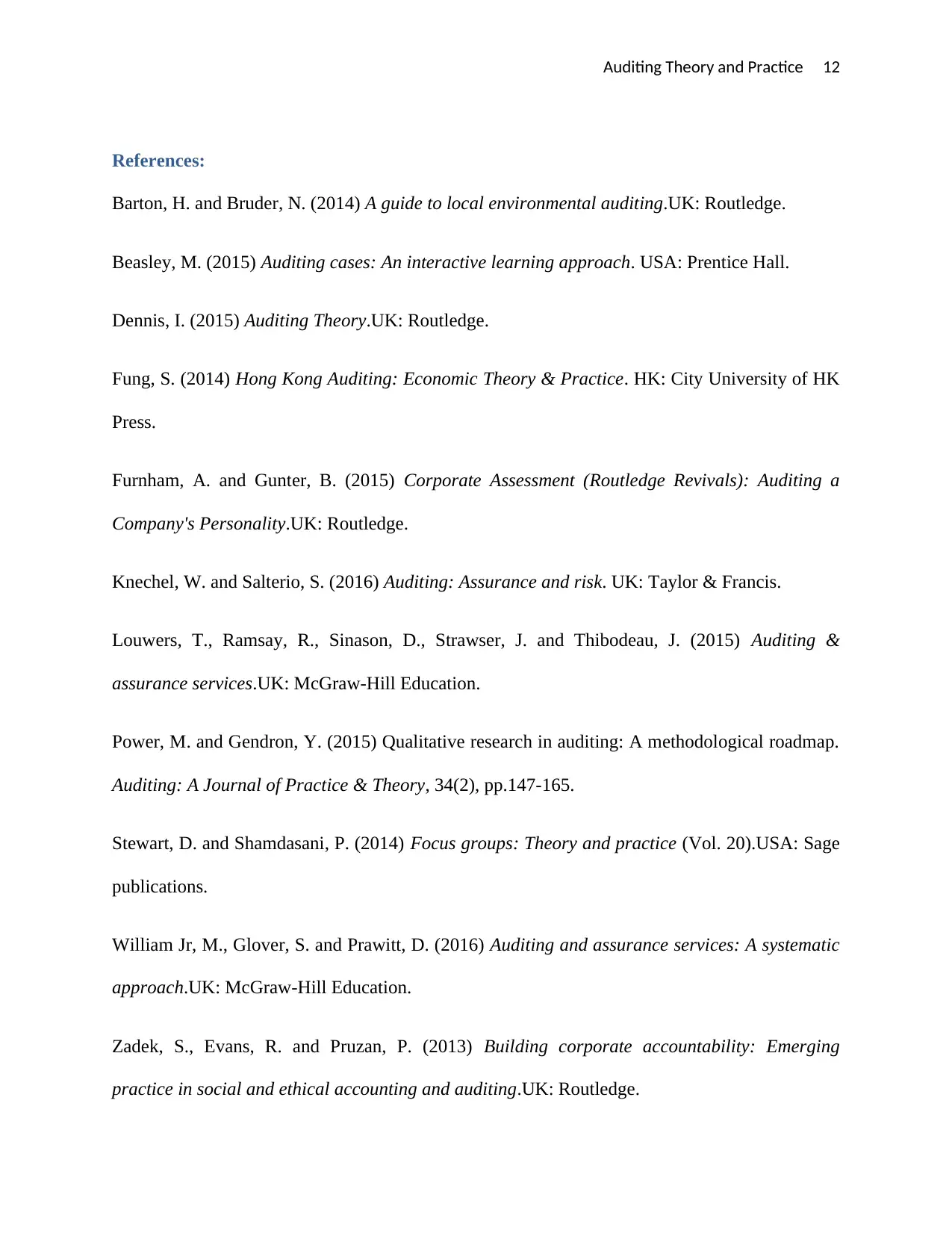
Auditing Theory and Practice 12
References:
Barton, H. and Bruder, N. (2014) A guide to local environmental auditing.UK: Routledge.
Beasley, M. (2015) Auditing cases: An interactive learning approach. USA: Prentice Hall.
Dennis, I. (2015) Auditing Theory.UK: Routledge.
Fung, S. (2014) Hong Kong Auditing: Economic Theory & Practice. HK: City University of HK
Press.
Furnham, A. and Gunter, B. (2015) Corporate Assessment (Routledge Revivals): Auditing a
Company's Personality.UK: Routledge.
Knechel, W. and Salterio, S. (2016) Auditing: Assurance and risk. UK: Taylor & Francis.
Louwers, T., Ramsay, R., Sinason, D., Strawser, J. and Thibodeau, J. (2015) Auditing &
assurance services.UK: McGraw-Hill Education.
Power, M. and Gendron, Y. (2015) Qualitative research in auditing: A methodological roadmap.
Auditing: A Journal of Practice & Theory, 34(2), pp.147-165.
Stewart, D. and Shamdasani, P. (2014) Focus groups: Theory and practice (Vol. 20).USA: Sage
publications.
William Jr, M., Glover, S. and Prawitt, D. (2016) Auditing and assurance services: A systematic
approach.UK: McGraw-Hill Education.
Zadek, S., Evans, R. and Pruzan, P. (2013) Building corporate accountability: Emerging
practice in social and ethical accounting and auditing.UK: Routledge.
References:
Barton, H. and Bruder, N. (2014) A guide to local environmental auditing.UK: Routledge.
Beasley, M. (2015) Auditing cases: An interactive learning approach. USA: Prentice Hall.
Dennis, I. (2015) Auditing Theory.UK: Routledge.
Fung, S. (2014) Hong Kong Auditing: Economic Theory & Practice. HK: City University of HK
Press.
Furnham, A. and Gunter, B. (2015) Corporate Assessment (Routledge Revivals): Auditing a
Company's Personality.UK: Routledge.
Knechel, W. and Salterio, S. (2016) Auditing: Assurance and risk. UK: Taylor & Francis.
Louwers, T., Ramsay, R., Sinason, D., Strawser, J. and Thibodeau, J. (2015) Auditing &
assurance services.UK: McGraw-Hill Education.
Power, M. and Gendron, Y. (2015) Qualitative research in auditing: A methodological roadmap.
Auditing: A Journal of Practice & Theory, 34(2), pp.147-165.
Stewart, D. and Shamdasani, P. (2014) Focus groups: Theory and practice (Vol. 20).USA: Sage
publications.
William Jr, M., Glover, S. and Prawitt, D. (2016) Auditing and assurance services: A systematic
approach.UK: McGraw-Hill Education.
Zadek, S., Evans, R. and Pruzan, P. (2013) Building corporate accountability: Emerging
practice in social and ethical accounting and auditing.UK: Routledge.
⊘ This is a preview!⊘
Do you want full access?
Subscribe today to unlock all pages.

Trusted by 1+ million students worldwide
1 out of 12
Related Documents
Your All-in-One AI-Powered Toolkit for Academic Success.
+13062052269
info@desklib.com
Available 24*7 on WhatsApp / Email
![[object Object]](/_next/static/media/star-bottom.7253800d.svg)
Unlock your academic potential
Copyright © 2020–2025 A2Z Services. All Rights Reserved. Developed and managed by ZUCOL.





